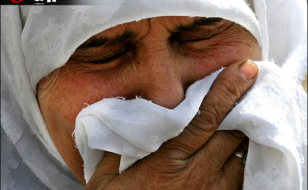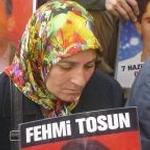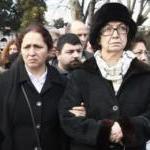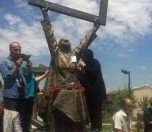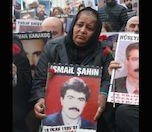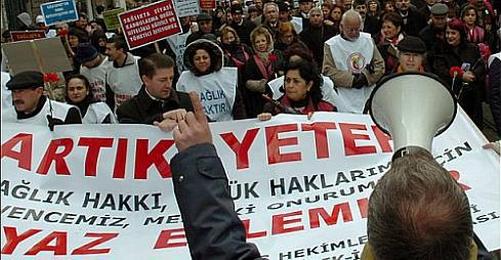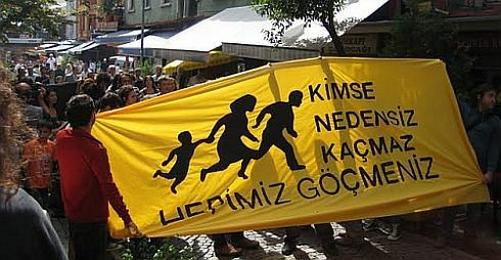Saturday, 31 January, marked a revival of the “Saturday Mothers” protests in Beyoğlu, central Istanbul.
New protests at old cases
Protesters used to meet in front of the Galatasaray school every Saturday from 1995 to 1995, holding up placards with pictures of missing persons, demanding to know their fate and the prosecution of those responsible. In the last seven months of the protests, security forces intervened at every protest. It became commonplace for the protesters to experience police detention for at least one night.
The movement started when Hasan Ocak, son of Emine Ocak, was taken into police custody on 21 March 1995. His tortured body was found in a cemetery for the poor fifty-five days later.
The gathering on Saturday was watched by a great number of police officers. Relatives of Ali İhsan Dağlı, Hasan Ocak, Rıdvan Karakoç, Cemil Kırbayır, Kasım Alpsoy, Serdar Tanış, Düzgün Tekin, İsmail Şahin and Hasan Gülünay were present, as well as activists protesting against their and other people’s disappearance.
Statements given during the Ergenekon trial have pointed to organised killings by JITEM, the clandestine Gendarmerie Anti-Terrorism Intelligence Unit. Bodies are said to have been hidden in acid wells and other places.
Perpetrators are protected
Leman Yurtsever of the Human Rights Association’s (IHD) Committee for People Disappearing in Detention has pointed out that the Ergenekon investigation is bringing to light what the Saturday Mothers/People were saying for years. Their voices were never heard.
On Saturday (31 January), protesters came together again to protest against the disappearance of Ali İhsan Dağlı, whose case has caused the European Court of Human Rights to convict Turkey. A corps commander, Hasan Kundakçı, was implicated, and he is now implicated in Ergenekon. Yurtsever asked why he was not being prosecuted. She said that although perpetrators of crimes were known, they were being protected.
"We do not have him"
A relative of Dağlı’s described his disappearance: “He was taken into custody in the Esme village, Silvan district of Diyarbakır in 1995. People who saw him in custody have made statements. There were even photos of him in custody published in the newspapers. All the efforts of his family and the Human Rights Association have remained fruitless. The state has never changed its answer: ‘We did not take him, we do not have him.’”
Systematic search for bodies needed
Yurtsever listed the demands of the protesters as follows:
“Wells, acid wells and mass graves need to be opened and searched. It is true that many people died in the so-called Sapanca triangle during (retired general and Ergenekon prime suspect) Veli Küçük’s time. They killed Behçet Cantürk, Rıdvan Karakoç, Hayrettin Eren and many others there. We don’t only want their bodies. The perpetrators need to be taken to trial.”
A specific demand is that the cases of the missing persons be merged with the Ergenekon trial, and that all those whose names appear in missing persons cases be put on trial.
Some examples of missing persons
Fehmi Tosun: arrested by plain clothes police in Avcılar, Istanbul on 19 October 1995, he was never heard of again.
Kenan Bilgin: Taken from his home in Ankara on 12 September 1994 by an Anti-Terrorism Squad, he was detained under suspicion of being a member of an illegal organisation.
Hayrettin Eren: Through friends he was able to tell his family that he was detained by security forces in Istanbul on 21 November 1980. His family saw his car in front of the Gayrettepe Police Station, but were told “he is not here.”
Rıdvan Karakoç: After being detained in Istanbul in 1995, his body was found. There was evidence of torture.
Hüseyin Morsümbül: He was taken fron his home in Bingöl on 18 September 1980 by gendarmerie and plain clothes officers. His father was also detained and tortured. In prison his father was told that his son had escaped, but he said, “not even a bird could have escaped from there.”
İsmail Şahin: He left his home in Istanbul on 18 January 1996 and never appeared again. A few days later his daughter Sibel told her mother that she had seen her father on Star TV news, being beaten by police.
Hüseyin Toraman: He was taken into custody on 7 October 1991 inIstanbul, and never heard of again. Kocamustafapaşa,
Hasan Gülünay: Detained in Istanbul on 20 July 1992, he has been missing ever since.
Ali İhsan Dağlı: According to the statement of a soldier B.G., Dağlı was suspected of being a PKK supporter. On 19 April 1995, he was trapped and wounded by Turkish security forces in the Kuruçayır village of Savur district in Diyarbakır province. The soldiers took him hostage. He was beaten by villagers and soldiers. A Huey helicopter provided by the USA arrived, and a high-ranking general carrying a US-patented M-16 helped to beat him up. The village was then burnt down and Dağlı taken away. An army officer later told B.G. that Dağlı died in custody. His body was never found.
Kasım Alpsoy: He was taken into custody from his home in Adana in May 1994. The next day his sister and her husband went to pick up his ID at the police station. Although they knew he was there, the police denied this. He was never heard of again. Following a witness statement that his body was in a grave in Mersin, permission was not given to open the grave. (EZÖ/AG)





